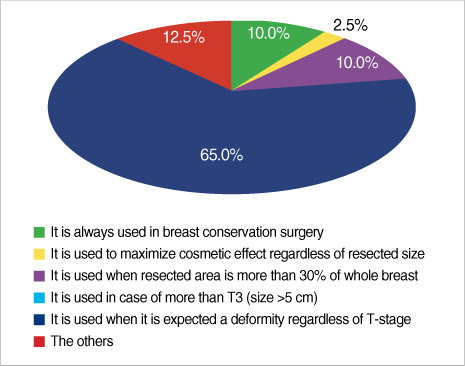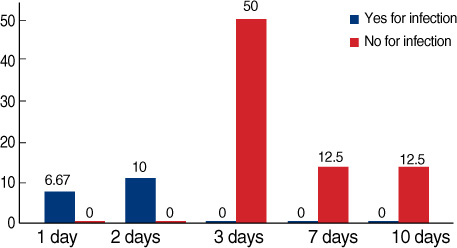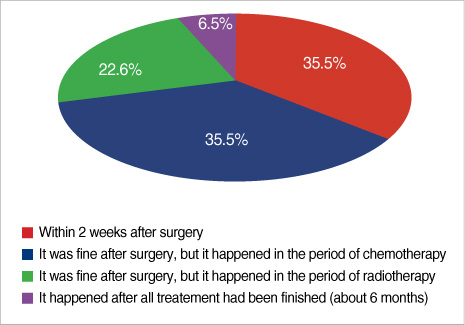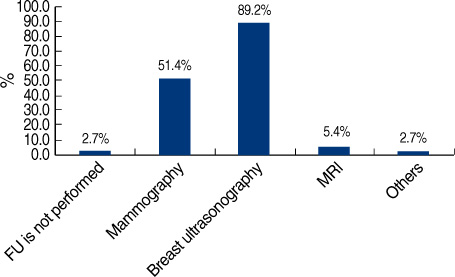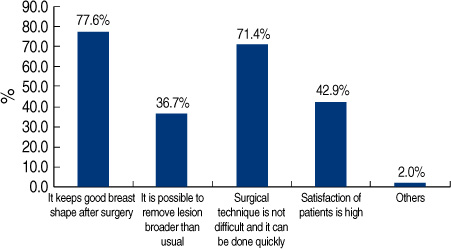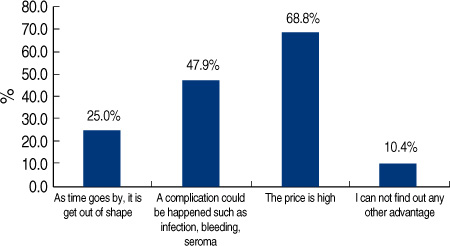Nationwide Survey of the Use of Absorbable Mesh in Breast Surgery in Korea
- Affiliations
-
- 1Department of Surgery, Ajou University School of Medicine, Suwon, Korea.
- 2Department of Medical Informatics, Ajou University School of Medicine, Suwon, Korea.
- 3Department of Surgery, Eulji University College of Medicine, Daejeon, Korea.
- 4Department of Surgery, Kangbuk Samsung Hospital, Sungkyunkwan University School of Medicine, Seoul, Korea.
- 5Department of Surgery, the Catholic University College of Medicine, Seoul, Korea.
- 6Department of Surgery, Kwandong University School of Medicine, Goyang, Korea. drgss@chol.com
- 7Korean Breast Cancer Society, Seoul, Korea.
- KMID: 2242013
- DOI: http://doi.org/10.4048/jbc.2009.12.3.210
Abstract
- The aim of this study is to investigate the use of absorbable mesh in breast surgery in Korea. We conducted a survey from members of Korea Breast Cancer Society by phone, E-mail, and notice on the website from 6th to 20th April 2009. A total of 54 breast surgeons had responded to the survey. Of these, 40 surgeons (74.1%) had used absorbable mesh during breast surgery, with Vicryl mesh(R) being the choice of every surgeon and Interceed(R) having been used by 36 (90%) of the surgeons. In responding to the indications for mesh use, 26 surgeons (65%) indicated that mesh use was effective when a deformity was expected regardless of T stage. Contraindications for mesh use principally included existing patients' comorbidity such as a wound healing problem, diabetes mellitus and immunocompromised condition. Thirty one surgeons (77.5%) had experienced an infection in the mesh insertion site. However, on a case basis, only 39 of 843 cases (4.6%) had resulted in an infection. In the follow up after mesh use, 33 of the 37 responding surgeons (89.2%) used breast ultrasonography. Nineteen of the 38 respondents (50%) replied that the mesh was absorbed in 6 months and it did not confuse diagnostic imaging. The cited merits of mesh included maintenance of breast shape following surgery (n=38/49, 77.6%) and ease of surgical use (n=35/49, 71.4%). However, the high price of mesh was cited as a disadvantage by 33 of the 48 respondents (68.8%). In summary, survey results mentioned above show that surgical mesh use in breast surgery is increasing by times and the procedures greatly varies by surgeons. Thereby, we suggest that a guideline for mesh use should be made in the near future.
Keyword
MeSH Terms
Figure
Cited by 3 articles
-
Results from Over One Year of Follow-Up for Absorbable Mesh Insertion in Partial Mastectomy
Min Young Koo, Se Kyung Lee, Sung Mo Hur, Soo Youn Bae, Min-Young Choi, Dong Hui Cho, Sangmin Kim, Jun-Ho Choe, Jung-Han Kim, Jee Soo Kim, Jeong Eon Lee, Seok Jin Nam, Jung-Hyun Yang
Yonsei Med J. 2011;52(5):803-808. doi: 10.3349/ymj.2011.52.5.803.Analysis of Infections Occurring in Breast Cancer Patients after Breast Conserving Surgery Using Mesh
Jin Seong Cho, Sun Hyoung Shin, Ji Young Park, Young Ju Song, Jeong Min Yi, Min Ho Park, Jung Han Yoon, Young Jong Jegal, Ji Sin Yi, Seong Ja An, Hwo Soon Lim
J Breast Cancer. 2011;14(4):328-332. doi: 10.4048/jbc.2011.14.4.328.The Suitability of Absorbable Mesh Insertion for Oncoplastic Breast Surgery in Patients with Breast Cancer Scheduled to Be Irradiated
Taehyun Kim, Heunglae Cho
J Breast Cancer. 2013;16(1):84-89. doi: 10.4048/jbc.2013.16.1.84.
Reference
-
1. The Korean Breast Cancer Society. Nationwide Korean breast cancer data of 2004 using breast cancer registration program. J Breast Cancer. 2006. 9:151–161.2. Ko SS. Korean Breast Cancer Society. Chronological changing patterns of clinical characteristics of Korean breast cancer patients during 10 years (1996-2006) using nationwide breast cancer registration on-line program: biannual update. J Surg Oncol. 2008. 98:318–323.
Article3. Fisher B, Bauer M, Margolese R, Poisson R, Redmond C, Fisher E. Five-year results of a randomized clinical trial comparing total mastectomy and segmental mastectomy with or without radiation in the treatment of breast cancer. N Engl J Med. 1985. 312:665–673.
Article4. Eom TI, Kim BS, Koo BY, Kim JW, Lim YA, Lee HH, et al. The use of a corrective procedure with vicryl mesh for oncoplastic surgery of the breast. J Breast Cancer. 2009. 12:36–40.
Article5. Clough KB, Lewis JS, Fitoussi A, Faucoult MC. Oncoplastic techniques allow extensive resection for breast-conserving therapy of breast carcinomas. Ann Surg. 2003. 237:26–34.
Article6. Ohuchi N, Harada Y, Ishida T. Breast conserving surgery for primary breast cancer: immediate volume replace using lateral tissue flap. Breast Cancer. 1997. 4:59–65.7. Rietjens M, Urban CA, Rey PC, Mazzarol G, Maisonneuve P, Garusi C, et al. Long-term oncological results of breast conservative treatment with oncoplastic surgery. Breast. 2007. 16:387–395.
Article8. Sanuki J, Fukuma E, Wadamori K, Higa K, Sakamoto N, Tsunoda Y. Volume replacement with polyglycolic acid mesh for correcting breast deformity after endoscopic conservative surgery. Clin Breast Cancer. 2005. 6:175.
Article9. Lee JH, Hong YI, Jeong JH, Lee JI, Lee JH, Moon HJ, et al. Volume replacement with polyglatin 910 mesh for breast reconstruction after endoscopy-assisted breast conserving surgery for treating early breast cancer: the early results. J Breast Cancer. 2009. 12:193–198.
Article
- Full Text Links
- Actions
-
Cited
- CITED
-
- Close
- Share
- Similar articles
-
- The Use of Absorbable Surgical Mesh after Partial Mastectomy for Improving the Cosmetic Outcome
- Ultrasonographic Findings of an Implanted Absorbable Mesh in Patients with Breast Partial Resection: a Preliminary Study
- The Suitability of Absorbable Mesh Insertion for Oncoplastic Breast Surgery in Patients with Breast Cancer Scheduled to Be Irradiated
- Imaging Findings of Implanted Absorbable Mesh in Patients with Breast Partial Resection
- Results of Absorbable Mesh Insertion and Patient Satisfaction in Breast-Conserving Surgery

